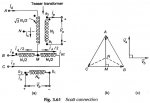Electricalhelp
Senior Member
- Location
- NJ
How do I balance the load for a 2 Phase 120/240V System?
For a 3 Phase System - I would balance the total load between A,B & C and then divide the VA by 240*√3 .
For a 1 Phase System - I would balance the total load between A & B and then divide the VA by 240.
So how many phases (A,B,C etc) will there by for 2 Phase and what would I divide the total load by.
For a 3 Phase System - I would balance the total load between A,B & C and then divide the VA by 240*√3 .
For a 1 Phase System - I would balance the total load between A & B and then divide the VA by 240.
So how many phases (A,B,C etc) will there by for 2 Phase and what would I divide the total load by.


